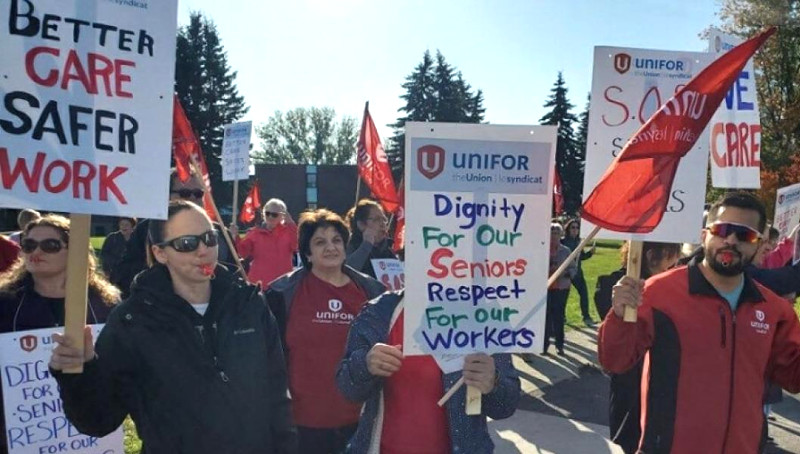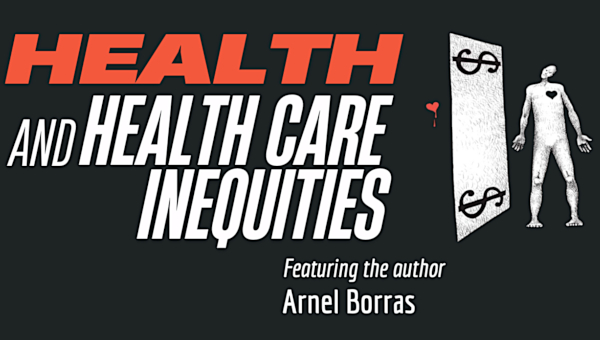Breaking Point in Long-Term Care in Ontario
Violence, the Pandemic, and Healthcare Workers
The COVID-19 pandemic has ravaged Ontario’s long-term-care homes. The majority of the province’s pandemic deaths have occurred in these institutions, where conditions became so dire the province was forced to call on the Canadian Armed Forces for desperately needed help. Those soldiers, in turn, observed conditions so appalling that a report was transmitted back to National Defence headquarters in Ottawa – a report so bleak that Premier Doug Ford has said reading it was the hardest moment of his time in office. The provincial government has pledged an independent commission to look into the LTC system; the provincial ombudsman has begun its own investigation. But Ontario’s LTC system has been extensively studied for years. The problems that made the pandemic so devastating had not been unknown. This week, TVO.org will catalogue just a few of the reports, papers, and other warnings regarding the state of our LTC system that were issued before the pandemic – and that we could have acted on. Today: Michael Hurley, president of the Ontario Council of Hospital Unions and one of the authors of the 2019 report Breaking Point: Violence Against Long-Term Care Staff.

Matt Gurney (MG): Before we get into the details of the pandemic’s toll on Ontario’s LTC system, I’d like to ask you specifically about the Breaking Point report – why did you and your colleagues choose to look specifically at the issue of violence in our LTC homes?
Michael Hurley (MH): Well, it actually started with violence in the hospitals. We knew anecdotally of instances of members being brutally assaulted at work, and we interviewed them. What we heard convinced us to do some polling. Then we did a research study in conjunction with the University of Stirling, in Scotland, with focus groups in hospitals. But that led us to become interested in the problem of violence in other areas of the health-care sector, where the staffing is even thinner than it is in a hospital. Understaffing was identified in the original hospital study as being a contributor to the violence, for a few reasons. One, the cuts that have occurred over many decades – cuts in real terms to staffing levels and to the number of available beds – have created access problems and quality problems that materialize for family members and for patients in hospitals. People feel that they or their loved ones are not being seen in a timely way or that the care that they’re receiving is inadequate or inferior. They’re operating in an atmosphere of high emotion and anxiety. And so, often, they lash out in totally unacceptable ways.
So we were interested in what is happening in the long-term-care system, because, in long-term care, through a series of government policy decisions dating back to the New Democratic government in the early 1990s, there was a decision made to effectively begin to close chronic-care hospitals in Ontario and to move the patient population into long-term care. The number of beds in our chronic-care and rehab hospitals shrank considerably. That caused an immediate surge in the LTC facilities. Wait-lists got longer, and the condition of the patients deteriorated – we started seeing patients who’d previously have been in a hospital being moved to the LTC system, and many of them had a variety of challenging physical and cognitive conditions; some had psychological disorders. Thousands of people were transferred over. And, as people lived longer, they got sicker – their medical conditions just got more and more complicated with age.
This really stressed the system. And we were very interested in whether violence was more prevalent, which it should be, theoretically. To be clear, I don’t mean that we hoped for more violence. But our previous study had identified risk factors, and, given the situation in the LTC facilities, we’d expect more of it there. So, we went looking. And what we found was horrifying levels of violence.
MG: Horrifying even beyond what you had seen in the hospitals?
MH: Horrifying like half the staff saying they’d been sexually assaulted at work. Ninety per cent saying they’d been physically assaulted. Overwhelming majorities of racialized staff saying they’d been targeted for racial harassment. There were differences, we found. Violence in a hospital setting tended to be more explosive, if I can call it that. In the LTC system, it was more normalized, almost. It was constantly in the background. It’s terrible, but this kind of problem had almost become routine in the workplace. A lot of the problems are similar. Because of the staffing constraints and the overwhelming demand, particularly for highly complex cases, families feel like their loved one isn’t getting appropriate care, and they can lash out.
MG: I’m sure that’s true, but there’s also the issue – and it’s terrible to talk about – that, in many cases where dementia is a factor, the residents themselves can be very violent. In my own family, and this isn’t fun to talk about, my grandfather, who’s been gone almost a decade now, he was a gentle, soft-spoken man in his healthy life, but he had severe Alzheimer’s near the end, and he became abusive, confrontational, even violent. People think Alzheimer’s and dementia means you become forgetful. You do. But, in some cases, the damage to your brain radically changes your personality, too. My grandfather would get up in the dead of night convinced he had to go catch the bus to ride to work, even though he’d been retired for decades. And he’d try to leave the facility. And if you tried to stop him, he could take a swing at you.
MH: Yeah. That’s right. This is a huge issue. Because of the staff shortages, the way in which residents are approached, there’s no time for subtlety, you know, because the staff are on such a treadmill. They move quickly from person to person, and there’s not a lot of time for what used to happen. There was more of a slower, methodical, gentle easing of people into certain tasks. “Let’s get dressed now” or “It’s time to get out of bed” or “Let’s go have lunch.” “I’m going to wash you now, okay?” That kind of thing.
All of the opportunity for that has been eliminated through what I guess you could call industrial re-engineering, where the job is basically broken down into physical tasks that have to be done, accompanied by tremendous amounts of paperwork and charting to satisfy the regulations of the ministry. There’s a tremendous dissatisfaction on the part of the residents, and their families, with the care they’re receiving, and for good reason. All of this has created a very tense, very violent workplace. I don’t think there’s anything else quite like it in the Canadian workforce.
MG: Yeah. This all tracks with my own experiences in LTC homes. I’ve already written about some of what I’d seen, so I wasn’t as shocked as many by how bad things got. But I was still shocked by some of it. Why do you think this is? I mean, I don’t want to throw anyone under the bus here by putting something on the record that was off the record, but when I reached out to your staff to arrange this interview, I told the person who called back that I wanted to talk with you about your long-term-care report. And she asked me, well, which one? We’ve done so many. So, this has been written about extensively. Why were we surprised?
MH: This issue was a slow burn for decades in Ontario. In a literature review that we did, it’s only in the last 20 years or so that the subject of violence against health-care staff has really been the subject of any widespread academic interest. We don’t know why. Maybe because the staff is so female-dominated or racialized? I honestly don’t know. There are certainly huge industrial interests involved in long-term care. It’s highly privatized, and there are a lot of powerful interests tied up in this. Bill Davis is on the board of Rivera; Mike Harris chairs Chartwell. There’s a lot of mobility between the industry and government or political positions. So, this is a very well-represented industry.
But, frankly, even beyond that, once you get into these quality issues, you begin to second-guess some basic assumptions of how we’re delivering long-term care, including whether, for example, operating on a for-profit basis is actually in the interest of the residents. We’re seeing this in COVID, but the Canadian Medical Association had already done great work on this. There are differences in outcomes. When we have payments of billions in dividends to shareholders, well, that money came from somewhere. That’s staff that wasn’t hired and cleaning that wasn’t done. That’s thousands of workers in these homes that don’t exist and that would lead to a much higher quality of life for the residents.
And for the staff. People reported they get into their car at the end of their shift, and they cry. They’re not crying for themselves because they were hit or insulted. They’re crying because they feel badly. They feel like they’re doing a shitty job. They’re not. They’re doing their best. But it’s an impossible task to provide care in an environment where there’s almost no staff.
MG: Obviously, the role of public and private ownership is going to be looked at in the various investigations now starting. I’m curious, was there an observable difference in the workplace experience between public and private facilities when you were working on the Breaking Point report?
MH: Huh. That would be interesting to know, actually. But, no, the data we gathered for that wasn’t broken down that way. But now I’m wondering. I’d like to know.

MG: Me, too! But that’s fine. Let’s talk a bit about the pandemic itself now. You’ve obviously seen the reports. I don’t want to ask you to prejudge the outcome of the future investigations, but you’ve obviously spent time in these facilities and thinking about them. What went wrong? Why did we get caught flatfooted and lose so many lives?
MH: I think you need to step back to demographics. We’ve got a baby boom aging. And think about the baby boom. It came after the Second World War. When the war was on, we knew we had to do a lot of things and spend a lot of money on the war. And then, after the war, the baby boom started, and we were like, well, okay, we need to build schools to educate the baby boomers. But we didn’t somehow realize we had to care for them at the end of their life. It really is a question of how are you going to meet your obligations to that generation, and the aging of the baby-boomer generation is now happening at a time of austerity and limited government spending. But honouring the health-care commitments to the baby-boomer generation is a one-time thing, right? Eventually, we don’t need all this capacity, because the boomers will gradually pass away. But we need the capacity now. We’ve cut capacity from the system, thousands of beds, just as the population is aging.
And then along comes COVID, and, all of a sudden, the government becomes alarmed because Ontario has the worst beds-to-population ratio anywhere of any developed country in the world. We’re tied with Sweden at the bottom. So they become alarmed. How will they deal with it? They decide they won’t transfer COVID patients in long-term-care facilities into hospitals; we’ll treat them where they are. Hong Kong had no deaths in long-term care. Vietnam had no deaths. Taiwan had no deaths in long-term care. They test, and when they find some, they transfer the patient to a hospital.
What this is is rationing. That’s where the long-term-care clientele is being victimized. There was fear in Ontario that we’d end up like New York or northern Italy, and we’d run out of ventilators. And one way to restrict access to hospitals was to have written pandemic plans people or their loved ones would sign, and they’d waive their right to transfer to a hospital. That protected hospital capacity, sure, but it wasn’t very thoughtfully done. People were critically ill in the LTC homes, without the equipment and specialized staff to care for them. Or enough staff of any kind.
And many people in these homes, they don’t stand up for themselves. I tell a story sometimes about a woman I knew: she was 85 years old, and she needed knee surgery, but her doctor didn’t want to give it to her, and she said, “Son, I still walk. I still cherish my life. I still like to be on my own two feet outside. Give me the surgery.” But not everyone speaks up on their own behalf like that. And not everyone has people to stand up for them when those pandemic plans were going around.
There was also the staffing issue. After SARS, we knew that you can’t have part-time staff working in many different facilities. In an outbreak, they spread it. We learned that after 2003, but then we relaxed. So COVID hits, and we order all the part-time staff to only work at one facility. And that was impossible to model – the staff had to make decisions about which facility they’d be at full-time, and some had enough and some lost huge parts of their staff. You couldn’t guess in advance which way any given home would go. And we were slow to close the long-term-care facilities to visitors. What happened wasn’t surprising.
MG: So, we’ve talked about two very different issues here. The violence in the homes, but also the specific act of the pandemic. And I’m guessing that just putting more staff in the homes would help address both.
MH: Yep. That’s the key thing – the first thing. More people to provide a much higher level of care. Doing that would bring down the level of violence. We need a minimum standard of care. The US congress did a ground-breaking study on this, and they found that if a resident in long-term care had about four hours of nursing and personal care a day, you can maintain their physical condition. If they got less than that, they would deteriorate. If they got a little more, they might even do better, they might gain mobility, see their health conditions improve. So, having some standard of care is essential, and conversations about ownership. Profits and dividends are coming from somewhere. It’s budget for more staff. It’s a better food budget. It’s more frequent cleaning.
Another big dynamic in long-term care, in particular, is that these workplaces are pretty dictatorial. They rely heavily on coercion and discipline. A lot of people get fired in this environment. And, of course, there are people who should be fired, for, say, patient abuse, but there is a lot of discipline. We need to look into that. Meanwhile, Quebec is hiring 10,000 personal support workers and is going to pay them $26 an hour. More people, making a decent wage, with full-time hours, is going to really improve morale. And that’s going to make the system better.
The system we have now is dehumanizing – for residents and staff alike. Our staff have a high rate of injury, a high rate of depression, a high rate of anxiety. One of the good sides of the pandemic is the public recognizing this. Maybe it will help us make a better system. •





